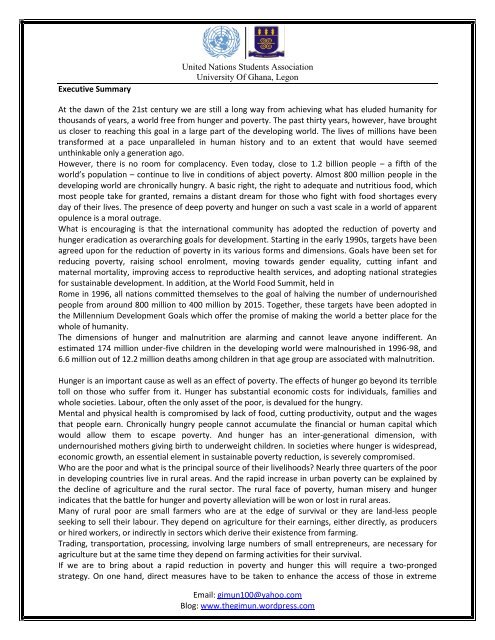United Nations Students Association University Of Ghana, Legon ...
United Nations Students Association University Of Ghana, Legon ...
United Nations Students Association University Of Ghana, Legon ...
You also want an ePaper? Increase the reach of your titles
YUMPU automatically turns print PDFs into web optimized ePapers that Google loves.
Executive Summary<br />
<strong>United</strong> <strong>Nations</strong> <strong>Students</strong> <strong>Association</strong><br />
<strong>University</strong> <strong>Of</strong> <strong>Ghana</strong>, <strong>Legon</strong><br />
At the dawn of the 21st century we are still a long way from achieving what has eluded humanity for<br />
thousands of years, a world free from hunger and poverty. The past thirty years, however, have brought<br />
us closer to reaching this goal in a large part of the developing world. The lives of millions have been<br />
transformed at a pace unparalleled in human history and to an extent that would have seemed<br />
unthinkable only a generation ago.<br />
However, there is no room for complacency. Even today, close to 1.2 billion people – a fifth of the<br />
world’s population – continue to live in conditions of abject poverty. Almost 800 million people in the<br />
developing world are chronically hungry. A basic right, the right to adequate and nutritious food, which<br />
most people take for granted, remains a distant dream for those who fight with food shortages every<br />
day of their lives. The presence of deep poverty and hunger on such a vast scale in a world of apparent<br />
opulence is a moral outrage.<br />
What is encouraging is that the international community has adopted the reduction of poverty and<br />
hunger eradication as overarching goals for development. Starting in the early 1990s, targets have been<br />
agreed upon for the reduction of poverty in its various forms and dimensions. Goals have been set for<br />
reducing poverty, raising school enrolment, moving towards gender equality, cutting infant and<br />
maternal mortality, improving access to reproductive health services, and adopting national strategies<br />
for sustainable development. In addition, at the World Food Summit, held in<br />
Rome in 1996, all nations committed themselves to the goal of halving the number of undernourished<br />
people from around 800 million to 400 million by 2015. Together, these targets have been adopted in<br />
the Millennium Development Goals which offer the promise of making the world a better place for the<br />
whole of humanity.<br />
The dimensions of hunger and malnutrition are alarming and cannot leave anyone indifferent. An<br />
estimated 174 million under-five children in the developing world were malnourished in 1996-98, and<br />
6.6 million out of 12.2 million deaths among children in that age group are associated with malnutrition.<br />
Hunger is an important cause as well as an effect of poverty. The effects of hunger go beyond its terrible<br />
toll on those who suffer from it. Hunger has substantial economic costs for individuals, families and<br />
whole societies. Labour, often the only asset of the poor, is devalued for the hungry.<br />
Mental and physical health is compromised by lack of food, cutting productivity, output and the wages<br />
that people earn. Chronically hungry people cannot accumulate the financial or human capital which<br />
would allow them to escape poverty. And hunger has an inter-generational dimension, with<br />
undernourished mothers giving birth to underweight children. In societies where hunger is widespread,<br />
economic growth, an essential element in sustainable poverty reduction, is severely compromised.<br />
Who are the poor and what is the principal source of their livelihoods? Nearly three quarters of the poor<br />
in developing countries live in rural areas. And the rapid increase in urban poverty can be explained by<br />
the decline of agriculture and the rural sector. The rural face of poverty, human misery and hunger<br />
indicates that the battle for hunger and poverty alleviation will be won or lost in rural areas.<br />
Many of rural poor are small farmers who are at the edge of survival or they are land-less people<br />
seeking to sell their labour. They depend on agriculture for their earnings, either directly, as producers<br />
or hired workers, or indirectly in sectors which derive their existence from farming.<br />
Trading, transportation, processing, involving large numbers of small entrepreneurs, are necessary for<br />
agriculture but at the same time they depend on farming activities for their survival.<br />
If we are to bring about a rapid reduction in poverty and hunger this will require a two-pronged<br />
strategy. On one hand, direct measures have to be taken to enhance the access of those in extreme<br />
Email: gimun100@yahoo.com<br />
Blog: www.thegimun.wordpress.com


